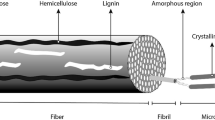Abstract
The drying process in typical pulp production generates strong hydrogen bonding between cellulose microfibrils in refined cell walls and increases the difficulty in obtaining uniform cellulose nanofibers. To investigate the efficacy of alkaline treatment for cellulose nanofibrillation, this study applied a bead-milling method in NaOH solutions for the nanofibrillation of dried pulps. NaOH treatments loosened the hydrogen bonding between cellulose microfibrils in dried pulps and allowed preparation of cellulose nanofibers in 8 % NaOH with a width of approximately 12–20 nm and a cellulose I crystal form. Both the nanofiber suspensions prepared in 8 and 16 % (w/w) NaOH were formed into hydrogels by neutralization because of surface entanglement and/or interdigitation between the nanofibers. When the dried pulp was fibrillated in 16 % (w/w) NaOH, the sample after neutralization had a uniquely integrated continuous network. These results can be applied to the preparation of high-strength films and fibers with cellulose I crystal forms without prior dissolution of pulps.



Similar content being viewed by others
References
Abe K, Yano H (2009) Comparison of the characteristics of cellulose microfibril aggregates of wood, rice straw and potato tuber. Cellulose 16:1017–1023
Abe K, Yano H (2010) Comparison of the characteristics of cellulose microfibril aggregates isolated from fiber and parenchyma cells of Moso bamboo (Phyllostachys pubescens). Cellulose 17:271–277
Abe K, Yano H (2011) Formation of hydrogels from cellulose nanofibers. Carbohydr Polym 85:733–737
Abe K, Yano H (2012) Cellulose nanofiber-based hydrogels with high mechanical strength. Cellulose 19:1907–1912
Abe K, Iwamoto S, Yano H (2007) Obtaining cellulose nanofibers with a uniform width of 15 nm from wood. Biomacromolecules 8:3276–3278
Awano T, Takabe K, Fujita M, Daniel G (2000) Deposition of glucuronoxylans on the secondary cell wall of Japanese beech as observed by immuno-scanning electron microscopy. Protoplasma 212:72–79
Cai J, Kimura S, Wada M, Kuga S, Zhang L (2008) Cellulose aerogels from aqueous alkali hydroxide–urea solution. ChemSusChem 1:149–154
Donaldson L (2007) Cellulose microfibril aggregates and their size variation with cell wall type. Wood Sci Technol 41:443–460
Eichhorn SJ, Dufresne A, Aranguren M et al (2010) Review: current international research into cellulose nanofibres and nanocomposites. J Mater Sci 45:1–33
Ho TTT, Abe K, Zimmermann T, Yano H (2015) Nanofibrillation of pulp fibers by twin-screw extrusion. Cellulose 22:421–433
Nishino T, Takano K, Nakamae K (1995) Elastic modulus of the crystalline regions of cellulose polymorphs. J Polym Sci Part A Polym Chem 33:1647–1651
Okano T, Sarko A (1985) Mercerization of cellulose. II. Alkalicellulose intermediates and a possible mercerization mechanism. J Appl Polym Sci 30:325–332
Siro I, Plackett D (2010) Microfibrillated cellulose and new nanocomposite materials: a review. Cellulose 17:459–494
Somerville C, Bauer S, Brininstool G, Facette M, Hamann T, Milne J, Osborne E, Paredez A, Persson S, Raab T, Vorwerk S, Youngs H (2004) Towards a systems approach to understanding plant cell walls. Science 306:2206–2211
Wang Z, Liu S, Matsumoto Y, Kuga S (2012) Cellulose gel and aerogel from LiCl/DMSO solution. Cellulose 19:393–399
Author information
Authors and Affiliations
Corresponding author
Rights and permissions
About this article
Cite this article
Abe, K. Nanofibrillation of dried pulp in NaOH solutions using bead milling. Cellulose 23, 1257–1261 (2016). https://doi.org/10.1007/s10570-016-0891-4
Received:
Accepted:
Published:
Issue Date:
DOI: https://doi.org/10.1007/s10570-016-0891-4




